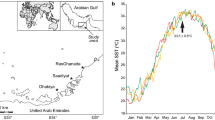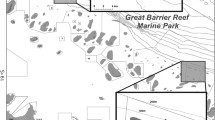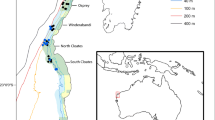Abstract
The microtides, wave regimes, and relative isolation of the Hawaiian archipelago may provide unique environmental and biogeographic effects that shape the structure of tidepool fishes. We sampled fishes across a narrow gradient at low tide from 6 sites on the island of O`ahu. We tested predictions of the hypotheses that environmental conditions (pool depth, volume, macroalgal cover, temperature, and salinity) would result in a vertically structured tidepool fish assemblage unique to basalt or limestone rocky shores. 343 fish were recorded from 40 pools, and 19 species from 10 families were identified. Tidepool fish diversity (H’: O`ahu = 2.4; Sites Average = 0.0–0.9) was typical for tropical islands, with members from Gobiidae (5 species), Blenniidae (4 species), Pomacentridae (3 species), Acanthuridae (2 species) and Kuhliidae (2 species) among the most common. Endemism (32%) was higher than other well studied assemblages yet similar to Hawaiian reef fishes (25%). Assemblage abundance varied among shores with basalt or limestone substrate, among sites, and vertically among high, mid, and low pools. In general, blenniids occurred at higher proportions on limestone shores and gobiids were more common on basalt shores. High pools were characterized by an abundance of a small sized (29.0 mm median standard length) blenniid Istiblennius zebra, while the blenniid Entomacrodus marmoratus and wrasses Thalassoma spp. were more common in low pools. Temperature was the best environmental predictor of assemblages and this relationship warrants further investigation. Our findings indicate that assemblages can vary across a narrow geographical range and intertidal shore.





Similar content being viewed by others
References
Abbott IA (1999) Marine red algae of the Hawaiian Islands. Bishop Museum Press, Honolulu
Anderson MJ, Gorley RN, Clarke KR (2008) PERMANOVA + for Primer: A guide to software and statistical methods PRIMER-E Ltd, Plymouth
Bird CE (2006) Aspects of community ecology on wave-exposed rocky Hawai'ian coasts. PhD, University of Hawai'i, Honolulu. 255pp.
Boyle KS, Horn MH (2006) Comparison of feeding guild structure and ecomorphology of intertidal fish assemblages from central California and central Chile. Mar Ecol Prog Ser 319:65–84
Castellanos-Galindo GA, Giraldo A, Rubio EA (2005) Community structure of an assemblage of tidepool fishes on a tropical eastern Pacific rocky shore, Colombia. J Fish Biol 67:392–408
Chang K-H, Lee S-C, Lee J-C, Chen C-P (1973) Ecological study on some intertidal fishes of Taiwan. Bull Inst Zool Acad Sinica 12:45–50
Clarke KR, Warwick RM (2001) Changes in marine communities: an approach to statistical analysis and interpretation. Primer-E Ltd, Plymouth
Connell JH (1961) The influence of intra-specific competition and other factors on the distribution of the barnacle Chthamalus stellatus. Ecol 42:710–723
Davis JL (2000) Spatial and seasonal patterns of habitat partitioning in a guild of southern California tidepool fishes. Mar Ecol Prog Ser 196:253–268
Denny MW, Paine RT (1998) Celestial mechancis, sea-level changes, and intertidal ecology. Biol Bull 194:108–115
Duci A, Giacomello E, Chimento N, Mazzoldi C (2009) Intertidal and subtidal blennies: assessment of their habitat through individual and nest distribution. Mar Ecol Prog Ser 383:273–283
Duhart M, Ojeda FP (1994) Ichthyological characterisation of intertidal pools, and trophic analysis of herbivore subtidal fishes of Easter Island. Med Amb 12:32–40
Floeter SR, Behrens MD, Ferreira CEL, Paddack MJ, Horn MH (2005) Geographical gradients of marine herbivorous fishes: patterns and processes. Mar Biol 147:1435–1447
Friedlander AM, DeMartini EE (2002) Contrasts in density, size, and biomass of reef fishes between the northwestern and the main Hawaiian Islands: the effects of fishing down apex predators. Mar Ecol Prog Ser 230:253–264
Gibson RN (1982) Recent studies on the biology of intertidal fishes. Oceanogr Mar Biol Ann Rev 20:363–414
Gibson RN (1999) Methods for studying intertidal fishes. In: Horn MH, Martin KLM, Chotkowski MA (eds) Intertidal fishes, life in two worlds. Academic, San Diego
Gibson RN, Yoshiyama RM (1999) Intertidal fish communities. In: Horn MH, Martin KLM, Chotkowski MA (eds) Intertidal fishes, life in two worlds. Academic, San Diego, pp 264–295
Godinho WO, Lotufo TM (2010) Local v. microhabitat influences on the fish fauna of tidal pools in north-east Brazil. J Fish Biol 76:487–501
Gosline WA (1965) Vertical zonation of inshore fishes in the upper water layers of the Hawaiian Islands. Ecol 46:823–831
Greenfield DW (2003) A survey of the small reef fishes of Kane’ohe Bay O’ahu, Hawaiian Islands. Pac Sci 57:45–76
Greenfield DW, Johnson RK (1990) Community structure of western Caribbean blennioid fishes. Copeia 1990:433–448
Griffiths SP (2000) The use of clove oil as an anaesthetic and method for sampling intertidal rockpool fishes. J Fish Biol 57:1453–1464
Griffiths SP (2003) Rockypool ichthyofaunas of temperate Australia: species composition, residency, and biogeographic patterns. Estuar Coast Shelf Sci 58:173–186
Griffiths SP, West RJ, Davis AR (2003) Effects of intertidal elevation on the rockpool ichthyofaunas of temperate Australia. Environ Biol Fish 68:197–204
Hiatt RW, Strasburg DW (1960) Ecological of the fish fauna on coral reefs of the Marshall Islands. Ecol Monogr 30:65–127
Horn MH (1989) Biology of marine herbivorous fishes. Oceanogr Mar Biol Ann Rev 27:162–272
Horn MH, Martin KLM, Chotkowski MA (1999) Intertidal fishes, life in two worlds. Academic, San Diego
Horn MH, Riegle KC (1981) Evaporative water loss and intertidal vertical distribution in relation to body size and morphology of stichaeid fishes from California. J Exp Mar Biol Ecol 50:273–288
Jokiel PL, Brown EK (2004) Global warming, regional trends and inshore environmental conditions influence coral bleaching in Hawaii. Glob Change Biol 10:1627–1641
Lee S-C (1980) Intertidal fishes of a rocky pool of the Sanhsientai, eastern Tawaiian. Bull Inst Zool Acad Sin 19:19–26
Macpherson E (1994) Substrate utilization in a Mediterranean littoral fish community. Mar Ecol Prog Ser 114:211–218
Mahon R, Mahon SD (1994) Structure and resilience of a tidepool fish assemblage at Barbados. Environ Biol Fish 41:171–190
Martin KLM (1995) Time and tide wait for no fish: intertidal fishes out of water. Environ Biol Fish 44:165–181
Mayr M, Berger A (1992) Territoriality and microhabitat selection in two intertidal New Zealand fish. J Fish Biol 40:243–256
Metaxas A, Scheibling RE (1992) Community structure and organization of tidepools. Mar Ecol Prog Ser 98:187–198
Mora C, Ospina AF (2001) Tolerance to high temperatures and potential of sea warming on reef fishes of Gorgona Island (tropical eastern Pacific). Mar Biol 139:765–769
Nakamura R (1976) Experimental assessment of factors influencing micorhabitat selection by the two tidepool fishes Oligocottus maculosus and O. synderi. Mar Biol 37:97–104
Paulin CD, Roberts CD (1993) Biogeography of New Zealand rockpool fishes. In: B.e. al. (ed.) Proceedings of the second international temperate reef symposium, 7–10 January 1992, National Institute of Water and Atmospheric Research Ltd., Auckland, New Zealand
Prochazka K, Chotkowski MA, Buth DG (1999) Biogeography of rocky intertidal fishes. In: Martin HMH, KLM CMA (eds) Intertidal fishes, life in two worlds. Academic, San Diego, pp 332–355
Randall JE (2007) Reef and shore fishes of the Hawaiian Islands. University of Hawaii, Sea Grant College Program, Honolulu
Smith JE, Hunter CL, Smith CM (2002) Distribution and reproductive characteristics of nonindigenous and invasive marine algae in the Hawaiian Islands. Pac Sci 56:299–315
Stimson J, Larned ST, Conklin EJ (2001) Effects of herbivory, nutrient levels, and introduced algae on the distribution and abundance of the invasive macroalga Dictyosphaeria cavernosa in Kaneohe Bay, Hawaii. Coral Reefs 19:343–357
Yoshiyama RM, Sassaman C, Lea RN (1986) Rocky intertidal fish communities of California: temporal and spatial variation. Environ Biol Fish 17:23–40
Zander CD, Nieder J, Martin KLM (1999) Vertical distribution patterns. In: Horn MH, Martin KLM, Chotkowski MA (eds) Intertidal fishes, life in two worlds. Academic, San Diego, pp 26–49
Acknowledgements
We would like to acknowledge Patrick Aldrich, Ross Langston, and Louise Giuseffi for their assistance in collection of fishes. In addition we thank Celia Smith for her guidance and are grateful for the comments from anonymous reviewers which helped to greatly improve this manuscript.
Author information
Authors and Affiliations
Corresponding author
Rights and permissions
About this article
Cite this article
Cox, T.E., Baumgartner, E., Philippoff, J. et al. Spatial and vertical patterns in the tidepool fish assemblage on the island of O`ahu. Environ Biol Fish 90, 329–342 (2011). https://doi.org/10.1007/s10641-010-9744-4
Received:
Accepted:
Published:
Issue Date:
DOI: https://doi.org/10.1007/s10641-010-9744-4




